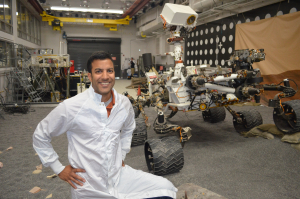The University of Houston Department of Electrical and Computer Engineering hosted a seminar last week, led by Ravi Prakash, a systems engineer with NASA’s Jet Propulsion Laboratory (JPL) — Entry, Descent and Landing (EDL) Systems group at the California Institute of Technology in Pasadena, Calif. Students, staff and faculty listened to Prakash’s detailed account of the Curiosity rover’s flawless landing on Mars in August of this year.
Prakash fielded questions from the audience about Curiosity’s extraordinary engineering and computing power. Curiosity’s target landing area was Gale Crater, at the foot of a layered mountain. The one-ton rover is equipped with 17 cameras that capture and send true-color images, and has a laser that zaps rocks from 20 feet away, allowing the use of spectroscopy to determine what the rock is made from. The Curiosity mission is also the first to Mars that relied on nuclear power.
Al Chen, the Flight Dynamics and Operations Lead for the Mars Science Laboratory EDL team, was heard on the NASA broadcast of the Curiosity landing saying “touchdown confirmed; let’s see where Curiosity will take us.” Prakash noted that, while Curiosity is the name of the rover, it also symbolizes so much more, speaking to the element of imagination and ingenuity that was responsible for this feat of engineering. “We always want to go further and farther. Let’s see where our human curiosity can take us,” he said.
Prakash, a native of Texas City, received a B.S. in aerospace engineering from the University of Texas at Austin and an M.S. in aerospace engineering from the Georgia Institute of Technology. He joined the JPL in 2005 and has worked at the Mars Science Laboratory ever since.
